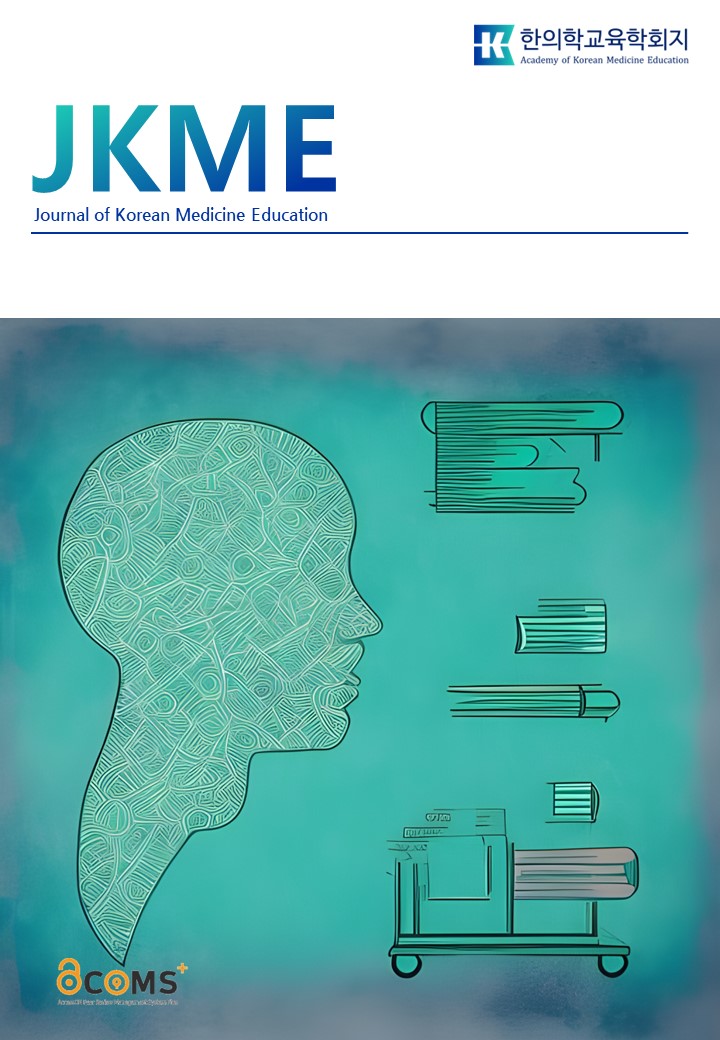1권 2호
초록
Abstract
Background and Methods: Argumentative writing is a writing method that logically and rationally organizes one's thoughts on a problem based on a novel and individual analysis of the situation. There are two types of logic; formal logic and informal logic. One of the most representative models of informal logic is the Toulmin argumentation model, which was reorganized into a new argumentation model by Williams and Colomb. Results and Discussion: The purpose of studying medical record is to refer to and verify the insights of predecessors in clinical practice and to utilize them to inherit and develop modern Korean medicine. It will be much easier to understand and use if argumentative writing is incorporated in researching medical record education of students majoring in Korean medicine.
초록
Abstract
Background; The importance of data science and data literacy in medical education is steadily increasing. However, there are challenges in teaching, learning, practicing, and comprehending these concepts in the medical educational field due to the lack of suitable software. The purpose of this study was to introduce the features and usage of Jamovi for immediate application in medical statistics classrooms. Methods and Results; This paper presents recent trends related to data literacy and provides step-by-step guidance on the key features, installation methods, screen layout, and essential usage of Jamovi, supplemented with screenshots. Discussion and Conclusion; An alternative was proposed for data literary education in the evolving medical education environment, known as eLearning. Jamovi is expected to enhance academic achievement of students and alleviate the workload of educators in medical education and research.
초록
Abstract
Background; Motivation enables students to learn in a self-directed attitude and is positively correlated with academic achievement. Although previous surveys have shown the need to supplement teaching methods to motivate learners in Korean medicine education, how students are motivated to learn and how to motivate students remains unknown. Methods and Results; The present study suggests a case of applying gamification to motivate learning in a Radiology class at a single College of Korean medicine. Kahoot! was used in two sessions of the Radiology class on Trauma and the Lumbar spine. The game mechanisms of Kahoot! such as time, points, and leaderboards drove learners’ motivation and concentration. Discussion and Conclusion; Quiz is feasible in Korean medicine education since it can also be applied in large classes. Nevertheless, the possibility of students feeling afraid of losing or stressed should be considered when applying Kahoot! in class. This case will be useful in introducing gamification in Korean medicine education and further research.
초록
Abstract
Background; Health systems science (HSS) is an emerging framework to specifically identify and to encompass factors which are essential to perform as ideal primary health care providers besides clinical knowledge or skills. This study aims to explore the possibility of implementing the HSS in Korean medicine education. Methods; Literature reviews and experts’ discussion were conducted. The literature reviews included basic principles and related researches on HSS, and classic texts in Korean medicine to investigate how the contents are related and how HSS framework can be adapted. Experts in medical education, Korean internal medicine, and Korean medical classics discussed considering the core concept, current curriculum and real clinical field. Results; Current curriculum includes parts of the core functional domains, specifically patient-centered clinical practice (patients’ concerns, expectation, thought, situation, and individual constitution), policy and economics and population and preventive Korean medicine. Some parts are educated but not sufficient or hidden, such as healthcare process, clinical informatics and health technology, value in health care and system improvement. Discussion and conclusion; HSS may help students to widen their view and to understand the big pictures of the overall contents. Further studies are needed to compare the current curriculum, especially in terms of medical humanities and social medicine, with the contents of HSS. In addition, larger-scale investigation and discussion is need to assess whether the current framework, named medical humanities, needs to be converted into HSS or not.
초록
Abstract
Background; Recently, Korean Medical Colleges are making efforts to improve the quality of Korean medicine (KM) education. KM, which freshmen encounter, is a potentially unfamiliar discipline to them, and it is important to investigate their perception of KM education. The purpose of this study was to investigate the factors of satisfaction and dissatisfaction of Korean Medical College students in the pre-KM curriculum. Methods; This qualitative study used focused group interview as the methodology. Six students recruited through purposeful sampling and snowball sampling participated in two rounds of semi-structured in-depth interviews. Each round lasted about 2 hours. The subjects' satisfaction and dissatisfaction factors with the pre-KM curriculum were categorized according to their characteristics. Results; Factors of satisfaction and dissatisfaction with the pre-KM curriculum were classified into academic, educational, and personal factors. The satisfaction factors included individualization-oriented characteristics of KM and friendly personal background to KM. As dissatisfaction factors, the unfamiliarity of knowledge related to KM and the conflict between knowledge systems were emphasized. In particular, the participants complained that the conflict between the education they had received through high school and that of KM was not well resolved. The reasons included unclear concepts and theories, the burden of failure, and the burden of memorization-oriented learning. Discussion and conclusions; The satisfaction factors and dissatisfaction factors investigated showed complex interactions with each other, and the definition and standardization of some ambiguous concepts, mitigation of the burden of failure, and understanding-oriented learning can be suggested as solutions to improve KM education. The results of this study will be used for the purpose of improving KM's curriculum in the future

